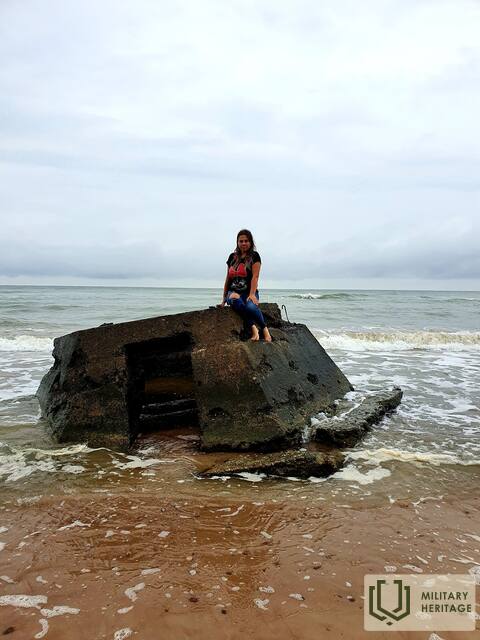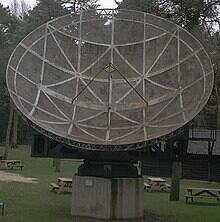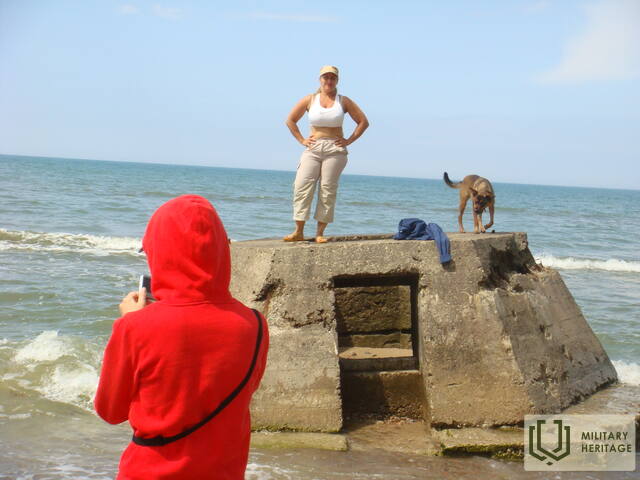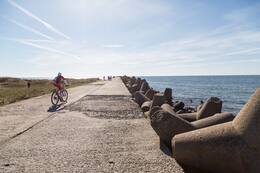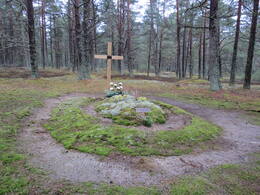Radarstation der deutschen Armee in Jūrkalne
Um die Kurzemesküste vor einem möglichen sowjetischen oder gar westalliierten Angriff zu schützen, errichtete die Bundeswehr an mehreren Stellen Radarstationen, die eine wesentlich frühere Erkennung feindlicher Luftaktivitäten ermöglichten. Eine davon wurde in Jūrkalne installiert.
Als die Rote Armee im Oktober 1944 die Halbinsel Kurzeme mit einem Teil der nationalsozialistischen deutschen Streitkräfte umzingelte, begann ein fast achtmonatiger Kampf in der Ostsee um die Versorgung der Heeresgruppe Kurzeme und später um die Evakuierung von Kurzeme. Bei den Kämpfen auf dem Meer spielte die Luftfahrt eine besonders wichtige Rolle. Um die Fähigkeit der deutschen Marine zur Bekämpfung sowjetischer Flugzeuge zu verbessern und die Kurzeme-Küste vor möglichen sowjetischen oder gar westalliierten Angriffen zu schützen, errichtete die Bundeswehr daher an mehreren Stellen Radarstationen, die eine wesentlich frühere Erkennung feindlicher Luftaktivitäten ermöglichten.
In Ulmale und Jūrmalne wurden höchstwahrscheinlich die deutschen Radaranlagen FuMG 65 Würzburg-Riese eingesetzt. Sie gehörten zu den modernsten und am häufigsten eingesetzten Radargeräten, von denen etwa 1.500 Exemplare hergestellt wurden. Es besaß eine 7 Meter hohe Parabolantenne, die ein Gewicht von 9 Tonnen erreichte. Das Radar hatte eine Reichweite von 70 Kilometern, knapp die Hälfte der Entfernung nach Gotland. Das Radar war in der Lage, den Anflug von Flugzeugen zu erkennen, was besonders in der Dämmerung wichtig war. Seine Peilung wurde genutzt, um die Strahlen der Flugabwehr auf das Ziel zu richten, was wiederum den Einsatz von Flugabwehrartillerie zur Zerstörung des Ziels ermöglichte.
Heute werden die Fundamente des Radars aufgrund der Küstenerosion jedes Jahr weiter ins Meer hinausgespült.
Zugehörige Zeitleiste
Zugehörige Themen
Zugehörige Objekte
Nordpier und Batterie Nr. 3 in Karosta
Die längste Seebrücke Lettlands - die Nordmole - wurde Ende des 19. Jahrhunderts als wichtiger Teil der Seefestung Liepaja und des Militärhafens gebaut. Die Länge des Piers beträgt 1800 Meter, die Breite 7,35 Meter.
Die Nordmole ist eines der ersten Hafenbauwerke von Zar Alexander III., das zwischen 1890 und 1892 vor der Ausgrabung des Karosta-Kanals errichtet wurde. Zusammen mit dem nördlichen Wellenbrecher, dem südlichen Wellenbrecher und der südlichen Mole bildete die Mole den Vorposten von Liepaja.
Die Festungsbatterie Nr. 3 von Liepaja befand sich neben der Nordmole des Karosta-Kanals und sollte die größte Bewaffnung haben. Es wurden Plattformen für vier 6-Zoll-Geschütze (152 mm) des Modells 1892 des Canet-Systems, fünf 11-Zoll-Geschütze (280 mm) des Modells 1887 und zwei 57-mm-Panzerabwehrkanonen von Nordenfeld sowie 18 9-Zoll-Geschütze (229 mm) und Mörser gebaut.
Heute ist die Batterie 3 am stärksten von der vorherrschenden Süd-Nord-Strömung betroffen, die hinter der Nordmole einen Strudeleffekt erzeugt, der zu Unterspülungen der Fundamente der Geschützplattform führt.
Die Nordmole schützt das Hafengebiet von Liepaja vor Nordwestwinden. Sie ist ein beliebter Ort für Einwohner und Besucher von Liepaja, um Sonnenuntergänge zu beobachten, zu angeln und das Meer bei unterschiedlichen Wetterbedingungen zu beobachten. Besonders spektakulär ist er bei Sturm.
An der Nordmole gibt es ausreichend Parkplätze. Dort gibt es auch Toiletten und ein Café mit einzigartigem Meerblick.
Gräber der litauischen Soldaten im Wald von Zaļkalns
Die Gedenkstätte befindet sich in der Nähe des Aussichtsturms am Strand von Pāvilosta in den Dünen. Es gibt Hinweisschilder, die zum Denkmal führen.
Am Ende des Zweiten Weltkriegs wurden drei litauische Polizeibataillone, das 5., 13. und 256. Bataillon, auch in Lettland eingesetzt, und nach Wachdienst und Kämpfen gegen sowjetische Partisanen und die Rote Armee an der Ostfront waren sie ab Herbst 1944 an der Bewachung der Ostseeküste in Kurzeme beteiligt.
Im Oktober 1944 wurden alle drei Bataillone mit 32 Offizieren und etwa 900 Ausbildern und Soldaten der 583. rückwärtigen Wacheinheit (Koruck 583) der deutschen 18. Die Einheit hatte den Auftrag, die Kurzeme-Küste von Liepāja bis Ventspils zu bewachen. Alle drei litauischen Bataillone wurden in der Nähe von Pavilosta eingesetzt. Im Dezember 1944 wurde das 13. Bataillon dem deutschen 1. Armeekorps am Liepaja-See unterstellt.
Zu den Aufgaben der litauischen Küstenwache gehörte neben der Abwehr feindlicher Anlandungen und der Meldung feindlicher Schiffe auch die Verhinderung der Überfahrt lettischer Flüchtlingsboote auf die 160 Kilometer entfernte Insel Gotland, doch die litauischen Küstenwächter verhinderten die Abfahrt der Flüchtlingsboote nicht. Die Nachricht, dass die litauische Küstenwache den lettischen Flüchtlingen half und die Litauer selbst die Überfahrt nach Schweden vorbereiteten, erreichte jedoch auch die Deutschen.
Am 10. Januar 1945 wurden die Soldaten der 1. Kompanie des 5. litauischen Polizeibataillons festgenommen. Es folgte ein mehr als einwöchiges Verhör und ein Prozess, bei dem als Warnung für die anderen beschlossen wurde, sieben der litauischen Soldaten hinzurichten und 11 ihrer Kameraden in deutschen Konzentrationslagern zu inhaftieren. Die Hinrichtung der sieben litauischen Soldaten (Feldwebel Macijauski, der Kompaniechef; Juozas Sendrjuas, ein Soldat; Vladas Salickas, ein Soldat; Ionas Bašinskis, Krasauskas und zwei unbekannte andere) fand am 21. Januar 1945 in den Zaļkalns Pines in Pavilosta statt.
Im Januar 1945 wurde das 5. Bataillon aufgelöst und die kampffähigen Soldaten wurden auf die beiden verbleibenden Bataillone aufgeteilt, während der Rest zu einer eigenen Pionierkompanie zusammengefasst wurde. Zum Zeitpunkt der Kapitulation der Heeresgruppe Kurzeme im Mai 1945 befanden sich noch zwei Bataillone (13. und 256.) als Pionierkompanie mit insgesamt 900 Soldaten in Kurzeme, die von den Sowjets gefangen genommen wurden.




